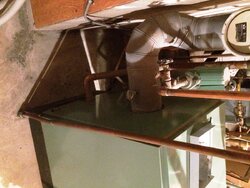quick recap: we moved in to this house in September. It was built in 1987 and has had only one owner (single woman, raised 2 daughters in it). There is a New Yorker WC-90 add-on boiler that was barely used, and the realtor said "she could never get it going right". I had a heating guy stop over to give me a good once-over, and everything seemed to check out just fine (valves, circulators, chimney, etc).
I've had several good fires in it since December with no issues until last week, when I noticed water on the floor close to my domestic storage tank. It too seems original, so I figured it had shat itself. Upon closer inspection, I found a bad solder joint in the return line to wood boiler. It's not a huge leak, just a steady drip. Maybe a quart a day.
So now the question: how do I get the water out of that pipe so that I can solder it? I do have the skills, and the stuff, but I know that making steam instead of heating copper is bad for business. Should I close off the feed + return ball valves to the oil boiler and then just use drain at the bottom of the wood boiler? Seems like an awful lot of water, but if that's the way then so be it. Thanks for reading.
I've had several good fires in it since December with no issues until last week, when I noticed water on the floor close to my domestic storage tank. It too seems original, so I figured it had shat itself. Upon closer inspection, I found a bad solder joint in the return line to wood boiler. It's not a huge leak, just a steady drip. Maybe a quart a day.
So now the question: how do I get the water out of that pipe so that I can solder it? I do have the skills, and the stuff, but I know that making steam instead of heating copper is bad for business. Should I close off the feed + return ball valves to the oil boiler and then just use drain at the bottom of the wood boiler? Seems like an awful lot of water, but if that's the way then so be it. Thanks for reading.



